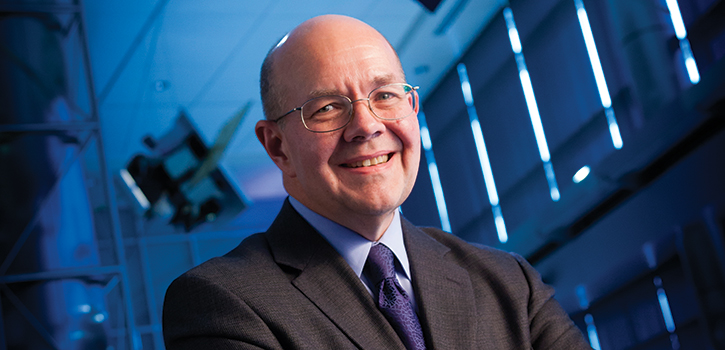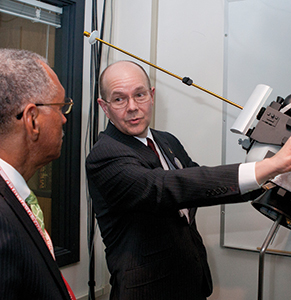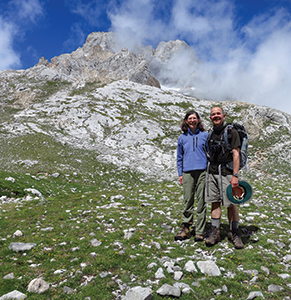Connecting physics & space: John C. Sommerer
John C. Sommerer, PhD, recently retired as senior fellow for National Space Policy at the Johns Hopkins Applied Physics Laboratory, where he had worked since 1980

Key technological advances in missile defense, homeland security and information security that affect all Americans — along with ongoing solar system exploration — have burgeoned under the leadership and guidance of Engineering alumnus John C. Sommerer, PhD.
At the Johns Hopkins Applied Physics Laboratory (APL), which he joined in 1980 and where he headed both its Research Center and later its Space Department, Sommerer oversaw advances in the physics of submarine detection, the MESSENGER Mission to Mercury, the New Horizons Mission to Pluto and the Missile Defense Agency’s Precision Tracking Space System.
APL, organized in 1942 to develop critical World War II technology and located near Washington, D.C., works to solve vital national security problems and to advance space science. Sommerer recently led APL’s development of NASA’s Van Allen Probes and a team of some 700 technical experts.
“At the dawn of the Space Age, James Van Allen discovered that the Earth is surrounded by two belts of pretty intense radiation,” says Sommerer, who earned bachelor’s and master’s degrees in systems science mathematics from WUSTL in 1979. “The International Space Station lives below these belts, which can damage satellites. We built a pair of spacecraft at APL that are up there now to help us understand how the belts change with time” — knowledge that could help satellite operators.

He also was lately involved in a NASA mission, slated for a 2018 launch, that would “send a probe into the sun’s outer atmosphere, its corona, where the temperature is millions of degrees,” Sommerer says.
Previously, as head of APL research, he led a team working to figure out materials to protect a spacecraft in that environment.
“(The material) is 8 inches thick,” he says. “When the front side is 2,700 degrees Fahrenheit, the backside, where the instruments are, is room temperature.”
Sommerer, who in January stepped down from his job leading the Space Department, was most recently APL Senior Fellow for National Space Policy before his April 4 retirement. He recently headed a technical panel for a congressionally mandated National Academy of Sciences study on the U.S. human spaceflight program. While unable to reveal the study’s results (slated for early summer release), he personally questions the emphasis on manned spaceflight, which now consumes half of NASA’s budget.
“We could maybe get people to Mars in the next 50 years at the cost of half a trillion dollars or, thanks to the explosion of robotic capabilities, send 100 top robotic spacecraft to explore the entire solar system.”
During Sommerer’s tenure, APL experienced significant growth, with its Milton S. Eisenhower Research Center quadrupling in size when he headed it. Additionally, in the early, post-Cold War ’90s, he led a committee challenged to protect APL’s future. The result was a three-pronged plan focused on missile defense, homeland security (“called counter-proliferation in pre 9/11 days,” he says) and national security concerns in the information sphere.
This year, the Sommerers are planning several adventures, including diving in Alaska, a foot safari in Zambia, a trip to ride with the Kazakhs as they hunt with their golden eagles in Mongolia and the Advent markets in Prague.
“This led to a substantial period of growth in which APL doubled in size,” he says.
Sommerer, who earned a master’s in applied physics from The Johns Hopkins University and a doctorate in physics from the University of Maryland, also has produced notable personal work in the field of nonlinear dynamics. His 1993 discovery of why one sometimes finds fractal patterns in fluid flows was featured on the cover of the journal Science.
He came to Washington University from Milwaukee to major in chemical engineering. But a freshman elective course on mathematical modeling taught by Ervin Rodin, PhD, changed everything.
“It completely opened my eyes to the power of the concept to capture properties of complicated systems mathematically,” Sommerer says.

He changed his major to what was then called systems science mathematics and has been a champion of the program ever since, continuing to serve as an external adviser to Arye Nehorai, PhD, chair of the Department of Electrical & Systems Engineering, and contributing to a scholarship fund named for Rodin, now senior professor.
“I’m a real booster,” Sommerer says. “It is an absolutely unique curriculum you could not get anywhere else in the country. It really prepared me to approach problems from a different perspective: When you find things that don’t correspond to your governing model, you check your assumptions. I apply that same schema to manage projects and organizations and to improve organizational performance. And at APL, I’ve had a chance to do a great number of things in one organization.”
Yet none of his noted successes may have happened without the financial aid Sommerer received via a Langsdorf Scholarship.
“I couldn’t have gone to Washington University if I hadn’t had that deal,” he says. “It meant everything to me.”
That includes “the most important thing” that happened to him at Washington University, meeting his wife of 35 years, Suzette Jacques, who earned a bachelor’s in chemical engineering at WUSTL in 1979.
Sommerer gives back to Washington University by serving as a member of the external advisory board for the Department of Electrical & Systems Engineering.
As to Sommerer’s future work, he says, “There are more interesting things to do than there is time to do them.”
Recently, at the urging of the Acting Deputy Secretary of Defense, he joined a National Academy of Sciences study to make recommendations on the future governance of National Nuclear Security Administration laboratories “so they can better serve the Department of Energy, Department of Defense, Department of Homeland Security and the U.S. intelligence community,” he says.
Back to Engineering Momentum